13 Mistakes You're Making When Cooking Beets
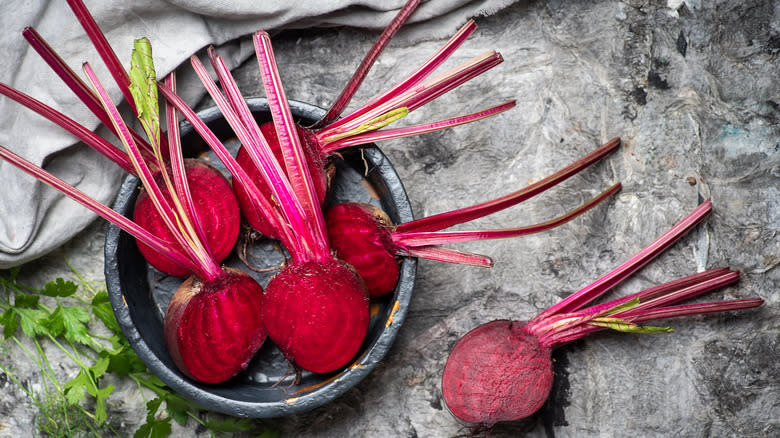
Our knowledge of beets often categorizes them as a magenta-colored root we should be implementing into our diet because it's packed with minerals, vitamins, and nutrients. We also associate the vegetable with a distinctive earthy quality that can be divisive. This hasty generalization has made beets one of the most misunderstood veggies that people usually love to avoid, instead of becoming informed on the different varieties and their amazing culinary potential.
It's time for beets to lose the undeserved stigma of being one of the most hated veggies in the U.S., and the way to do so is to learn how to cook them correctly to highlight their best attributes. We assembled the most common mistakes that stop you from getting the best version of home-cooked beets. Avoiding even just some of these issues will highlight the fact that this resistant root vegetable can be dressed up to make stunning and incredibly tasty dishes.
Read more: Mistakes You're Making With Your Corn On The Cob
Peeling Them
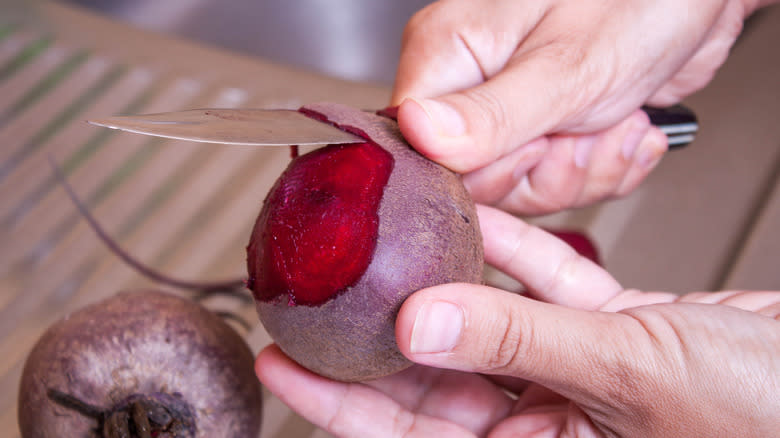
When cooking with beets, we usually make the mistake of immediately going for the vegetable peeler. Though beets are root vegetables, they usually only require a thorough scrub, and in most cases, there is no need to peel them. Their skin is edible and relatively thin, especially if the beet is young and fresh. You might only want to peel off the skin if you plan to steam or puree the beets.
If you skip peeling, make sure the quality of your beets is satisfactory, and preferably go for those labeled pesticide-free. Also, remember that beets usually have a mildly bitter skin, so make sure to adjust the flavors of your dish by adding sweetness.
If the recipe suggests otherwise or you still want to peel your beets, don't do it before cooking, as beets are toughest to peel when fresh. Their vibrant color also transfers easily, so it generally just makes an unnecessary mess. The easiest way to remove the skin is after they are cooked and cool, preferably under running water. You can use your fingers or a paring knife to remove the skin, but try to be as gentle as possible as cooked beets are tender.
Ignoring Different Variety Of Beets
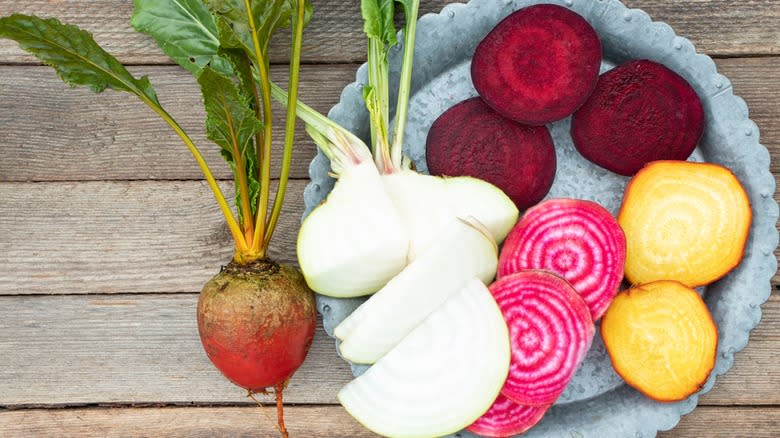
Many people wrongly assume that beets only come in the classic red variety. Though this is the most common version you'll find in stores and at the farmer's market, the world of beets is wonderfully diverse, and you should be choosing the variety depending on what you want to get out of it.
Classic red beets have a dominantly earthy flavor that is toned down with subtle sweetness, which enhances with cooking and roasting. They are a great all-rounder that will work in most dishes. Yellow-colored golden beets have a milder and sweeter flavor, and can be used the same way you'd use red beets.
Cylinder beets have a unique elongated, cylinder-like shape. They are perfect for pickling or slicing into uniform discs. As they are on the sweeter end of the spectrum, they are wonderful freshly sliced in salads. The Chioggia variety is especially striking. Also called candy cane, this Italian heirloom has pink flesh with a unique striped pattern, which makes it desirable for salads. It can be eaten raw or cooked but tends to lose the striped pattern after cooking.
Besides these varieties, there are other less common beets you can find on the market or grow at home. Though beets are usually available year-round, they hit their peak in spring or fall.
Wasting The Greens
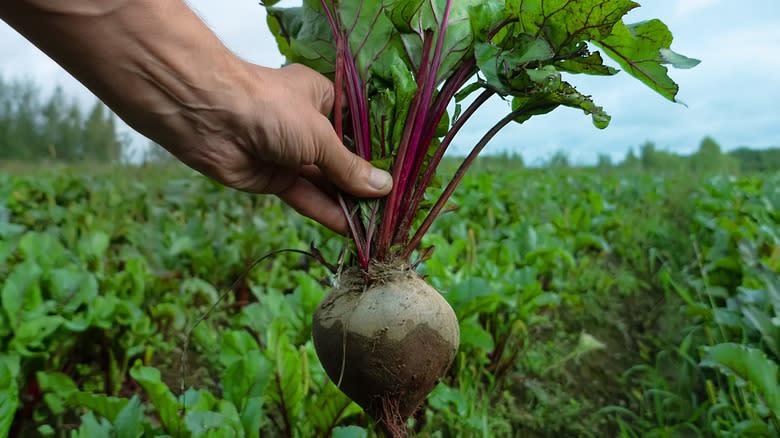
Broadly speaking, beets consist of two main parts: the root, which comes in different shapes and colors, and the lush leafy green top. When beets enter the culinary narrative, we often make the mistake of concentrating only on the edible root, missing out on the delicious green leaves nestled on the top. Of course, you don't want to cook with sad, wilted greens or leaves covered in blemishes, so make sure they look nice and fresh.
As there are so many beet varieties, not all the greens are the same, but most can be used in the kitchen. Rinse them well first, then remove the chunky and tough parts of stalks or any chewy bits. After that, you can use them the same way you'd use chard or spinach and expect a similar flavor too.
The greens make a wonderful side dish when sauteed in olive oil, preferably paired with garlic for more flavor. They're great in omelets or to enrich soup and stews, but finely sliced leaves can also be used raw, ideally as a salad ingredient or a garnish. You can even parboil the greens, toss them in ice-cold water, drain them well, and pack them in a ziplock bag to freeze for later use.
Incorrectly Storing Them
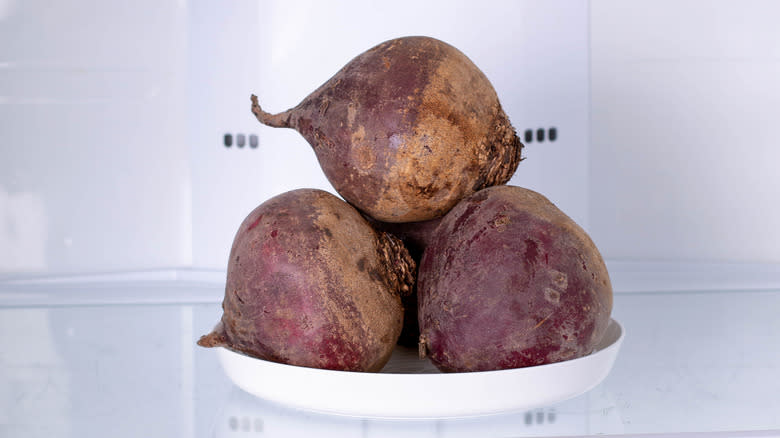
Perhaps the best thing about beets is that they keep amazingly well and can easily retain freshness and other good qualities for a relatively long time. But this is only possible if the beets are stored properly.
The mistake we often make is wrapping beets in plastic and shoving them in the fridge. To successfully store them, avoid this technique as the beets are likely to soak up moisture, lose firmness, and become mushy. You also want to avoid washing them beforehand, as any wet residue can soften them. The best thing to do is to chop off the stems, brush off any visible dirt, and store the beets in the crisper drawer, where they can stay for up to two months.
Freezing is another great way to preserve the freshness of your beets. If you know you won't eat them right away, you can cook the beets until tender and toss them into ice-cold water to help them preserve their vibrant color. Cut the beets into chunks, pack them into freezer bags, and store them. Frozen beets will retain freshness and color, and you can easily take out the amount you need. This storage option is great if you plan to use beets in soups, stews, or smoothies.
Not Exploring Their Full Potential With Diverse Cooking Techniques And Recipes
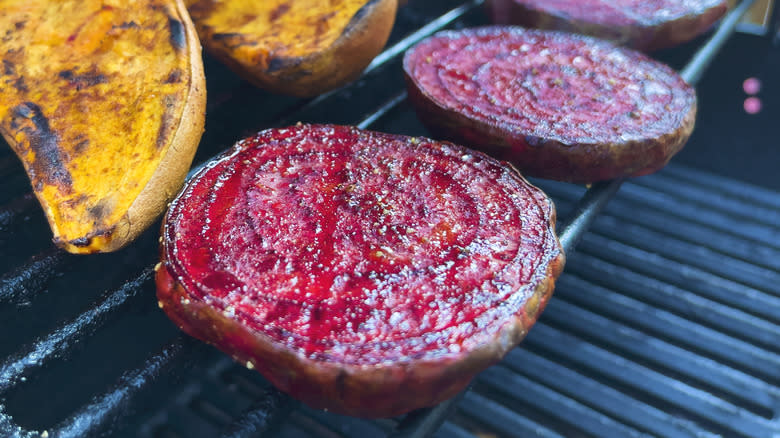
Roasting is perhaps the superior technique for cooking beets, as it yields a tasty batch of tender beets you can use in multiple ways. However, the root vegetable has way more culinary potential and it would be a mistake to miss out on the wide assortment of recipes.
Cooking beets can be as straightforward as boiling them in water until fork tender. A great trick is to add a splash of lemon juice or vinegar to the water to help preserve the vibrant color. You could also add herbs and seasoning to impart more flavor. If you really want to maintain the vegetable's qualities and textural integrity, steaming is perhaps the best option. However, don't forget that grilling is an easy method to get tons of smokiness and sweetness.
Once you adopt other cooking techniques, it's time to learn how you can use beets. We largely ignore beets as an ingredient in salads, but toss them in raw and grated for crunchiness, color, and tons of flavor. Cooked or roasted beets blend well into soups -- think of the legendary borscht -- while a pureed version is a wonderful addition to risotto or dip. The vegetable is a delicious component of vegan patties or nutrient-dense smoothies, or you can always rely on cooked or steamed beets as a simple side dish.
Thinking You Can Only Roast Beets Using The Tin Foil Method
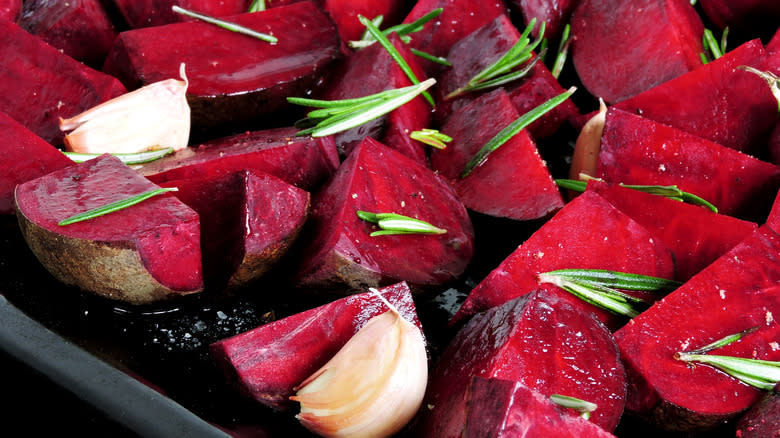
The go-to method for roasting beets usually involves wrapping them in tin foil after removing the greens and thoroughly cleaning them. Once wrapped in foil, assemble the beets on a sheet pan and roast them at 400 F. They are considered done if you can pierce the root easily with a knife or a fork, which usually takes around 45 minutes depending on the size. If you're not a fan of cooking with foil or you want to avoid unnecessary waste, there are other equally efficient ways to roast beets.
The easiest method is to place whole beets inside a deeper baking dish and coat them with olive oil. You can cover them with a lid and transfer the dish to the oven and roast them at 400 F. Though it also depends on the size, this technique will take approximately the same time as the tin foil method. If you want a faster option, slice or dice the beets into smaller chunks. Always drizzle with olive oil, and if desired, add onions, garlic, and your favorite seasonings to amp up the flavor. Beets roasted without foil will be perfectly caramelized from their natural sweetness.
Failing To Adjust Cooking Time According To Size
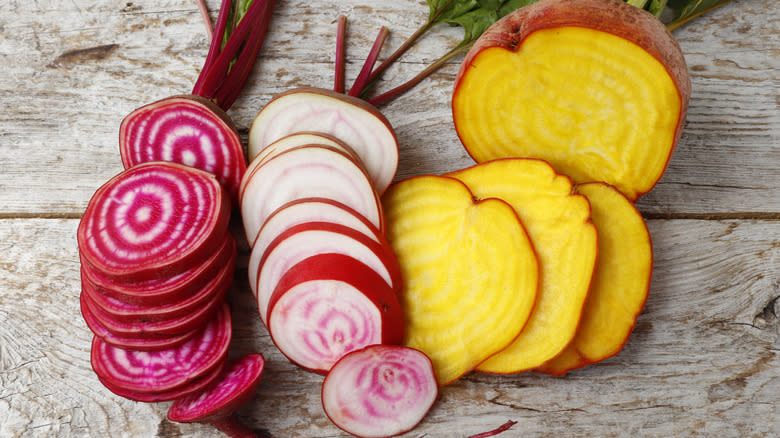
This mistake usually happens when we blindly follow a recipe without taking into account whether the size of the beets used is the same or at least similar to what we're using. This is a common scenario with beets because the size can significantly vary, even among the same variety. If your beets are smaller than those in the recipe, they might overcook and become too mushy, which is only desirable if you're making mashed beets or a puree. On the other hand, you definitely want to avoid undercooked beets, as the mistake results in an unpalatable mix of tender, chewy, and tough pieces.
The best advice here is to continually test as you cook. Use a paring knife or a fork to pierce through cooked, steamed, or roasted whole beets. When cooking smaller chunks, make sure to cut evenly-sized pieces so they cook at the same time. You can rely on the cooking time stipulated in a recipe if your beets are similar in size, but remember that oven temperatures vary and can be quite finicky, so it's best to do an additional check partway through.
Missing All The Wonderful Opportunities To Infuse Beets With Flavor
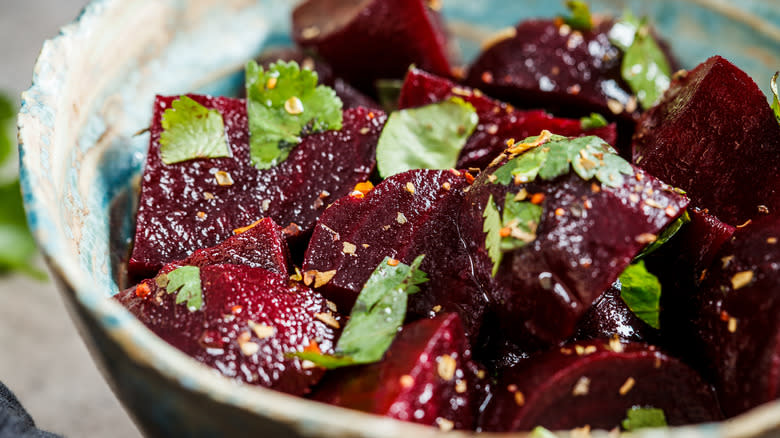
Salt and pepper are the usual seasonings you'll see on beets. Though you should keep using them, don't make the mistake of ignoring other flavor combinations with mixed herbs, spices, and seasonings. Because of their inherent earthy sweetness, beets are the perfect canvas to play with.
One of the best ways to dress them up is with herbs and greens, as the fragrant herbal notes will give earthy beets a much-desired freshness. The same applies to citrus -- lime, lemon, and orange are top choices to add zest and brightness -- or try ginger to take it to the next level. Meanwhile, play up the sweetness with a drizzle of honey over roasted beets or in the vinaigrette. Garlic is a standard addition that has enough aromatics to break through and provide balance for cooked beets or beet-based salads. A drizzle of balsamic vinegar over roasted beets is another way to add depth and complexity while amplifying the sweetness.
For a tasty option, try Geoffrey Zakarian's recipe, which calls for cooking beets in water flavored with red wine vinegar, salt, coriander, peppercorns, and sugar. Once tender, slice and serve them drizzled with sage-flavored olive oil, wine vinegar, salt, and pepper.
Thinking You Have To Cook Beets
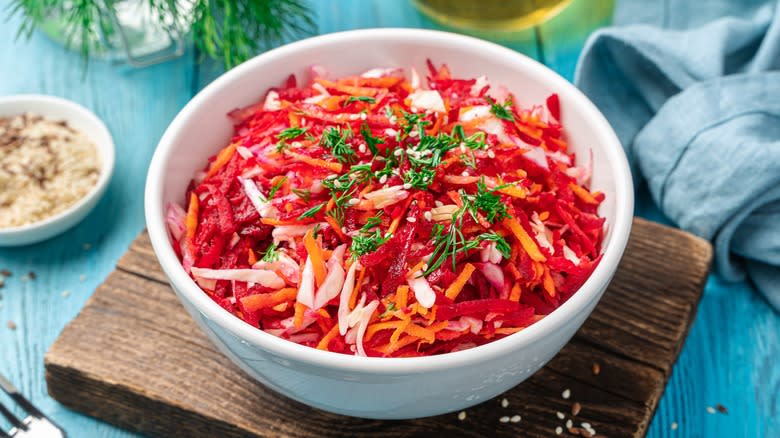
Aside from all the ways to cook beets, don't forget that you can consume them raw with surprisingly tasty results. You can eat fresh beets grated or sliced, depending on whether you want them to retain more of a crunch. Since the skin tends to be chewy and more bitter than the flesh, it is generally discarded before slicing or grating raw beets. The signature earthiness will be especially present, so balance those flavors with zesty citrus, tangy vinaigrette-style dressings and some sweet add-ons.
Raw beets are often incorporated into nutritious salads and paired with carrots or crisp, juicy apples to add sweetness. Toasted nuts and goat cheese also tend to go especially well with these combinations. You can even toss beet greens into the mix as they can be eaten raw. Also, fresh beetroot can be juiced along with the greens to make a nutrient-dense drink.
Not Using Them As A Natural Coloring Agent
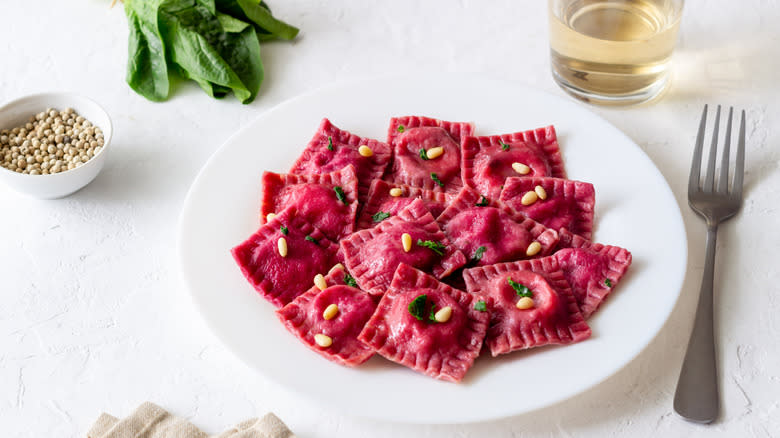
We often emphasize how beets have the unique talent to stain everything they touch, but the big mistake is not using this quality as an advantage. Their concentrated color makes beets one of the best ingredients to use as a natural food coloring. Simply extract the juice or use a thick beet puree, or alternatively, make a brine with water, beet juice, vinegar, and sugar. Y can use the juice as is, or you can also simmer it down, add sugar and lemon juice to concentrate and stabilize the mix, and then use it as you would any store-bought food dye.
You don't have to strictly control the amount you use in savory dishes. Use the tangy brine to make stunning pickled eggs, or opt for the juice or puree to make pasta, gnocchi, or to add an eye-catching hue to dips and spreads. Since even a little beetroot juice goes a long way, it can be added to sweets and desserts, but be careful about the flavor intensity. Ideally, whip a few drops into frosting or buttercream for a range of pink or red shades.
If you're not up for pureeing or extracting juice, beetroot powder is easily available in spice stores. It is usually made with dehydrated beets ground into a fine powder and can be mixed with water or added directly to a dish.
Not Using Plastic Boards Or Wearing Gloves
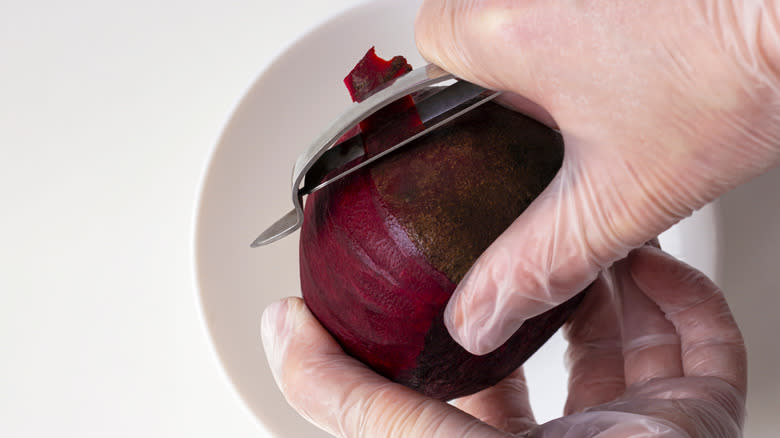
Many people are hesitant to cook with beets because of the potential mess. Beets stain everything around, and if you don't clean the juice immediately, there's a high probability you'll be scrubbing those purple stains long after you finish cooking. The mistake is not to prepare and protect beforehand, and the easiest way to do so is by using gloves and a plastic cutting board.
Gloves are an easy solution to prevent that pesky purple color from staining your hands when peeling or slicing beets. Using plastic instead of wooden cutting boards is another way to reduce the mess. Wood tends to soak up juices quickly, while plastic is less likely to do so and easier to wash up afterwards. An additional tip is to cover your cutting board in cling wrap and simply toss it out when you're done slicing and prepping.
Ignoring The Immense Potential Of Cooking With Canned Or Pickled Beets
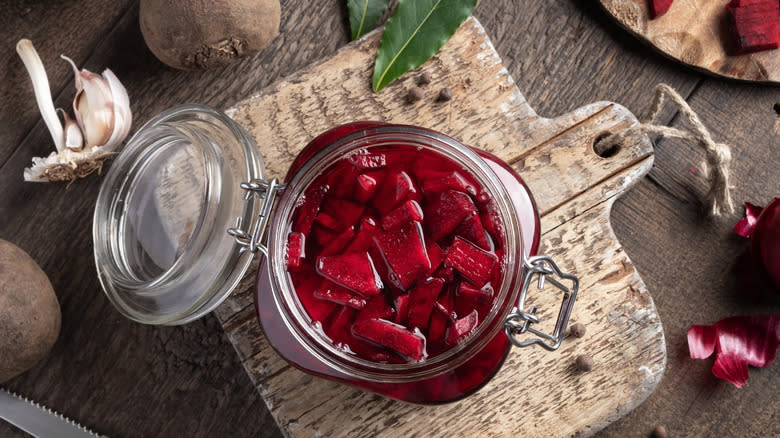
Talking about cooking with beets would not be complete without mentioning canned or pickled beets. Besides being widely available all year round, they are a convenient way to incorporate beets into recipes.
Canned beets are preserved in water and come whole or sliced. They usually don't have any added flavorings, which makes them a more versatile option for dips, soups, salads, spreads, or smoothies. They are also a great side dish or addition for veggie patties.
On the other hand, pickled beets have a tangy flavor from the vinegar used to preserve them. They are often enriched with spices, which will amplify any dish you add them to. You can turn pickled beets into relish and use it as a garnish or condiment for sandwiches. Pickled beets are also great for hummus, dips, and spreads, but adjust the flavorings to balance the tanginess. Adding them to salads is a quick way to use them without fuss.
Assuming That Beets Are Only Designed For Savory Recipes
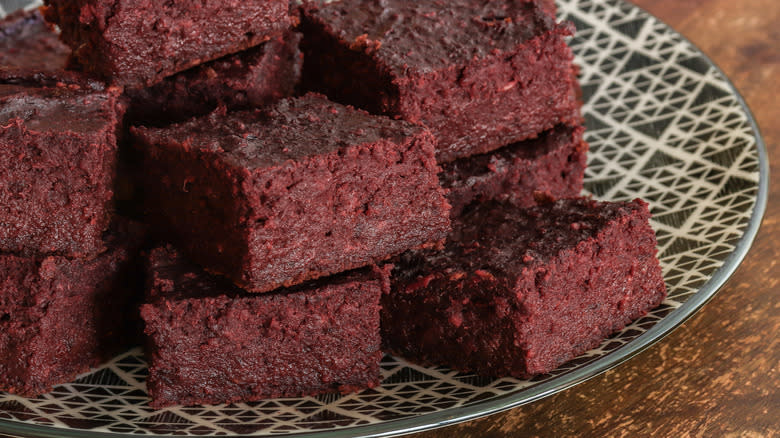
Beets should not be restricted to savory dishes. We often assume their dominant earthy profile can only blend with savory flavors, but beets can perform surprisingly well in desserts. Beets are typically finely grated or mashed into a fine puree and blended into the batter, but you can always roast them to enhance the sweetness.
Beetroot and chocolate are classic partners as they match in intensity and character, which is most evident in a robust chocolate cake or classic brownie. You won't be able to taste the texture difference, but the vegetable will impart a lot of moisture and make the juiciest chocolate cakes and fudgiest brownies. That earthy flavor will come through, but in combination with chocolate and sugar it makes for a harmonious taste with incredible depth and complexity. As well, you can mix the vegetable into purees, cookies, ice cream, or frozen yogurt.
Read the original article on Mashed


